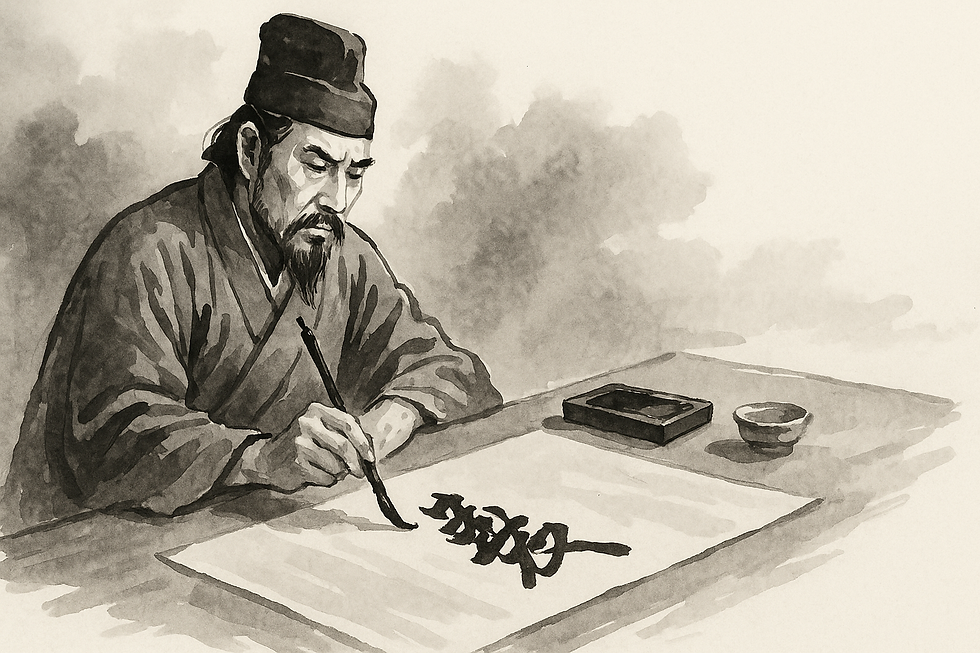Soga no Umako and Japanese Calligraphy — The Buddhist Temples That Gave Birth to a Tradition of Writing
- 清水 芳樹
- 5月31日
- 読了時間: 3分

Japanese calligraphy is more than the art of writing beautiful characters. At its heart lies a long history rooted in faith, prayer, and spiritual refinement. One of the key starting points of this tradition was the establishment of Buddhist temples and the emergence of sutra copying during the Asuka period by a visionary leader: Soga no Umako. In this article, we explore how Japanese calligraphy became deeply embedded in the spiritual culture of Japan through its ties to Buddhist institutions.
The Birth of Buddhist Temples and the Rise of Sutra Copying
One of Soga no Umako’s most significant achievements was founding Asuka-dera (also known as Hōkō-ji), the oldest full-scale Buddhist temple in Japan. But temple building was not just about constructing a place of worship — Asuka-dera became a center for learning, cultural exchange, and artistic expression. It gathered monks, scholars, and scribes who would shape the intellectual and artistic legacy of early Japan.
As Buddhism spread, so did the need to accurately transmit its teachings. This gave rise to the practice of shakyō — the copying of sutras by hand. Using brush and ink, monks carefully transcribed every character, one by one. Sutra copying was not merely duplication — it was a spiritual discipline. The act of writing itself was seen as a way to internalize the Buddha’s teachings and calm the mind. Great care was taken with each stroke, infusing every word with intention and reverence.
Calligraphy as a Mirror of the Heart
From this period, a core philosophy of Japanese calligraphy began to take shape: “Sho wa kokoro no kagami” — “Calligraphy is a mirror of the heart.” In the context of sutra copying, it was believed that the state of the writer’s heart directly affected the quality of the writing. A restless heart would result in disorderly characters, while a calm mind would yield graceful, composed script.
This idea — that writing reflects the writer’s inner world — became the foundation of Japanese calligraphy aesthetics, and remains central even today. Calligraphy evolved beyond technique into an expressive art form through which individuality, humanity, and spiritual depth could be conveyed.
The Spread of Kanji Through Buddhism
Along with Buddhism, Soga no Umako also helped embed kanji — the Chinese writing system — into Japanese society. Characters began appearing on temple plaques, sutras, statues, official records, and more. As people encountered the forms and meanings of kanji, they gradually developed their own stylistic interpretations, giving rise to what we now recognize as uniquely Japanese calligraphy.
Sutra copying, in particular, became an arena for artistic experimentation. Though the characters were the same, styles varied from temple to temple, and from hand to hand. This diversity helped cultivate calligraphy as an art form, not just a skill.
Temples as Hubs of Learning and Culture
The temples Soga no Umako built became more than spiritual sites — they became centers of education and culture. Monks, scholars, and artisans honed their writing techniques through daily practice. These temples also housed texts and documents, preserving knowledge for future generations. This tradition of cultural centers within temples laid the groundwork for future calligraphy schools and famous temples across Japan.
The Enduring Legacy of Soga no Umako
Today, Japanese calligraphy continues to carry the essence of prayer, self-cultivation, and spiritual artistry. From exhibitions and school lessons to kakizome (New Year’s calligraphy) and shakyō experiences at Zen temples, calligraphy remains an intimate part of Japanese life. Its global popularity as “Japanese calligraphy” has grown — but its deep roots lie in the Buddhist culture and temple practices fostered by Soga no Umako.
Conclusion
In the temples and Buddhist culture initiated by Soga no Umako, Japanese calligraphy transformed from mere writing into an art that reflects the heart. The legacy of every carefully written character has built the foundation for the beauty and depth of Japanese calligraphy as we know it today.
To truly understand Japanese calligraphy is to connect with a quiet strength and the spiritual richness of Japan’s cultural heritage.
Experience authentic Japanese calligraphy:



Comments